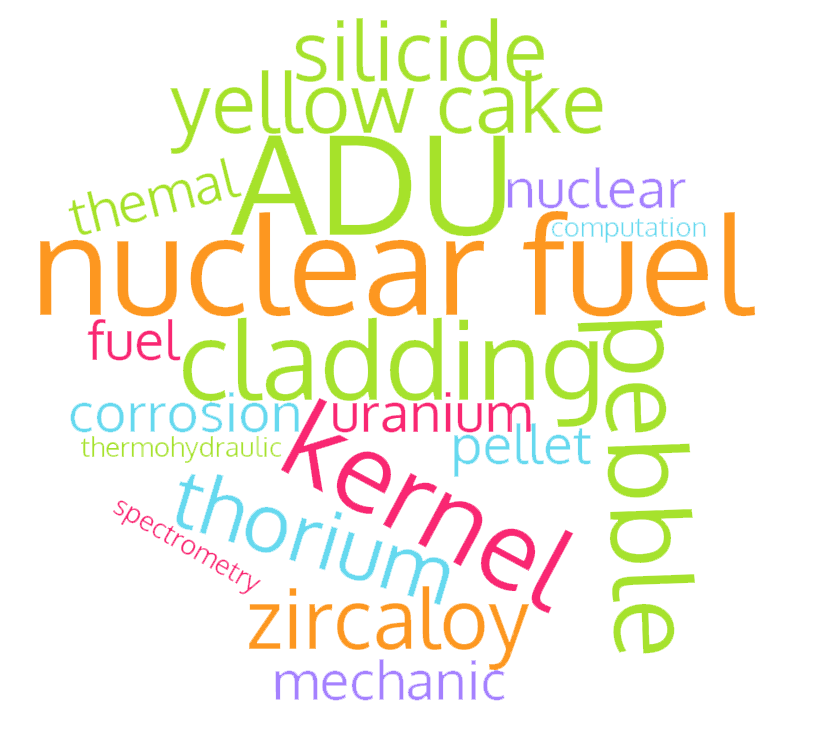PENGARUH KANDUNGAN MOLIBDENUM TERHADAP PERUBAHAN FASA DAN KAPASITAS PANAS INGOT PADUAN UMo
DOI: http://dx.doi.org/10.17146/urania.2011.17.2.1101
Sari
PENGARUH KANDUNGAN MOLIBDENUM TERHADAP PERUBAHAN FASA DAN KAPASITAS PANAS INGOT PADUAN UMo. Telah dilakukan analisis perubahan fasa dan kapasitas panas terhadap paduan UMo variasi 7%Mo, 8%Mo dan 9%Mo. Analisis perubahan fasa dilakukan menggunakan Differential Thermal Analysis (DTA) pada temperatur antara 30oC hingga 1400oC dengan kecepatan pemanasan 10oC/menit dan analisis kapasitas panas dilakukan menggunakan Differential Scanning Calorimetry (DSC) pada temperatur antara 30oC hingga 450oC dengan kecepatan pemanasan 5oC/menit. Tujuan penelitian ini adalah untuk mengetahui karakter paduan UMo antara lain perubahan fasa dan kapasitas panas dengan variasi kandungan Mo karena kenaikan kandungan Mo diduga akan mengubah kedua karakter paduan U7%Mo, U-8%Mo dan U-9%. Hasil analisis menunjukkan bahwa paduan 7%Mo, 8%Mo dan 9%Mo mengalami perubahan fasa a + d menjadi fasa a + β pada temperatur 578,63oC hingga 580,16 oC. Pada temperatur 606,50 oC hingga 627,58oC mengalami perubahan fasa dari a + β menjadi β + γ yang diikuti dengan reaksi endotermik pada kandungan 9%Mo dengan entalpi ΔH= 6,5989 J/g. Pada temperatur 1075,45 oC hingga 1160,51oC terjadi perubahan fasa β + γ menjadi fasa γ. Kenaikan kandungan Mo hingga pemanasan pada temperatur 1100oC tidak menyebabkan perubahan fasa yang signifikan. Pada temperatur diatas 1177,21oC, kenaikan kandungan Mo menyebabkan terjadinya perubahan fasa dari γ membentuk fasa L+γ yang diikuti reaksi antara uranium dengan Mo membentuk fasa γ - larutan padat (solid solution). Semakin tinggi kandungan Mo, panas reaksi yang dibutuhkan dan dilepaskan semakin besar. Hasil analisis kapasitas panas diperoleh bahwa kenaikan kandungan Mo dalam paduan U-7%Mo, U-8%Mo, dan U-9%Mo tidak memberikan perbedaan kapasitas panas yang signifikan. Hal ini di buktikan dengan melakukan uji beda (uji F) pada derajat kepercayaan 95%. Hasil Penelitian ini diharapkan dapat digunakan sebagai langkah awal untuk mempelajari pembuatan paduan UMo sebagai bahan bakar reaktor riset densitas uranium tinggi.
Kata kunci : Bahan bakar dispersi, paduan UMo, reaktor riset
THE EFFECT OF MOLYBDENUM CONTENT WITH CHANGES IN PHASE AND HEAT CAPACITY OF UMo ALLOY. Has done the analysis of phase and heat capacity change of the UMo alloy by variation of 7% Mo, 8% and 9% Mo. Analysis performed using phase change Differential Thermal Analysis (DTA) at a temperature between 30oC until 1400oC with heating rate 10oC/menit and heat capacity analysis carried out using Differential Scanning Calorimetry (DSC) at a temperature between 30oC to 450oC with heating rate 5oC/menit. The purpose of this study was to determine the character of the UMo alloy include phase change and heat capacity variation with Mo content due to higher content of Mo is expected to change both the character U-7% Mo alloy, U-8% Mo and U-9% Mo. The analysis showed that of 7% Mo, 8%Mo and 9% Mo the combination experiencing a + d a phase change becomes a + β phase at temperatures of 578.63°C to 580.16°C. At the temperature 606.50°C to 627.58°C having a phase change of a+ β to β + γ be followed by the endothermic reaction in the content of 9% Mo with the enthalpy ΔH = 6.5989 J / g. At temperatures 1075.45 oC up to 1160.51 oC phase change β + γ into γ phase. The increase in Mo content to heating at a temperature 1100oC not cause a significant phase change. At temperatures above 1177.21oC, the increase in Mo content leads to changes in the γ phase of forming L + γ phase which followed the reaction of uranium with Mo to form γ phase - solid solution. The higher content of Mo, the reaction heat is needed and released the greater. The results of the analysis of the heat capacity is obtained that the increase in Mo content in the U-7% Mo, U-8% Mo, and U-9% Mo alloy does not give a significant difference in heat capacity. This is attested by doing different test (F test) at 95% degree of confidence. This data is expected to be as a first step to study the manufacture of UMo alloy as a fuel of high uranium density for research reactor.
Key words: dispersion fuel, UMo alloy, research reactorTeks Lengkap:
PDFRefbacks
- Saat ini tidak ada refbacks.
Penerbit: Pusat Riset Teknologi Bahan Nuklir dan Limbah Radioaktif
Diindeks oleh:









